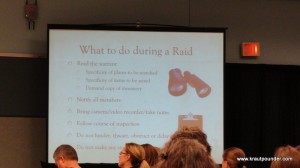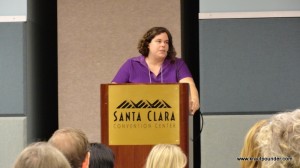|
|
This comes to us from the good folks from the Farm and Ranch Freedom Alliance:

|
|
|
October 17, 2013
|
|
Take Action of FDA’s Proposed Food Safety Regulations by November 15 Deadline
|
|
| About Us |
FARFA is a national organization that supports independent family farmers and protects a healthy and productive food supply for American consumers. FARFA promotes common sense policies for local, diversified agricultural systems.
|
|
Dear Lisa,
The FDA’s proposed food safety regulations pose significant problems for sustainable farmers, food producers, and food hubs across the country.
Under the proposed regulations, many farmers will be forced to comply with high-cost, industrial-scale regulations, and they will be unable to use traditional, sustainable growing practices. Food hubs and local food businesses will be forced to deal with costly and burdensome paperwork. Ultimately, consumers will face increased food prices and reduced availability of locally and sustainably produced foods.
Below is information on how YOU can help, with sample comments to the FDA and more! For more information on the specifics of the proposed regulations, scroll to the end of the alert or use the Quick Links on the left.
|
|
 TAKE ACTION – Submit Comments to the FDA TAKE ACTION – Submit Comments to the FDA
Below is a sample letter on the FDA’s proposed rules. Comments must be received by the agency by Friday, November 15, 2013.
To submit comments by mail:
- Use the sample as a starter for your own comments; you can also view the text online (http://bit.ly/FSMA-sample-letter) or you can download a Word version for editing, from http://bit.ly/FSMA-sample-letter-download
- Sign your full name
- Mail to the address shown on the letter below
To submit comments online, go to:
Steps for submitting comments online:
- We recommend that you write your comment ahead of time and save it on your computer — there is a time limit when using the Federal Register System, and you may get timed out if you write your comment from scratch.
- If your comment is less than one page, you can copy and paste it into the comment box. If it is longer, you can instead write “see attached” and UPLOAD a separate document, such as a Word or PDF file, with your comments.
- Uncheck the box that says “I am submitting on behalf of a third party,” so that you do not have to enter an organization name.
- For category, select “individual consumer” or “private industry.”
- Click “continue.”
- Check the box that you have read and understood the statement, and be sure to click “submit comment.” You should be taken to a new screen with a confirmation number.
- Remember that the Tester-Hagan provision is found in both rules, so if you file comments online, be sure to submit them on both rules.
It is very important to personalize your comments! We’ve included some questions in italics in the Sample Letter below, to help you think about some of the comments you can make about the specific impact on you.
|
 Sample Letter Sample Letter
The italicized portions at the beginning are intended to help you personalize your comments. You don’t have to write a lot – even a couple of sentences can really increase the impact your comments will have!
Division of Dockets Management (HFA-305)
Food and Drug Administration
5630 Fishers Lane, Room 1061
Rockville, MD 20852
Re: Preventive Controls Rule: FDA-2011-N-0920 and RIN 0910-AG36
Produce Standards Rule: FDA-2011-N-0921, and RIN 0910-AG35
I am a ______ [farmer, food producer, consumer, parent…]. I am deeply concerned about the impact that FDA’s proposed rules under FSMA would have on [my farm, my food business, the farms that I buy food from…].
For consumers, do you make an effort to buy from farms that use sustainable practices? Why do you care about these rules? Just a sentence or two is sufficient to explain.
If you are a farmer, explain your farm practices that would be impacted by the rule. Do you use manure, vermicompost, or compost teas? Do you use surface water or multiple different water sources? Do you do rotational grazing of your livestock with your crops, or use draft horses?
Do you have a CSA that involves more than one farm and would thus be required to do a HARPC plan? Do you do low-risk activities, such as bottling honey, grinding grains, or making jam? Do you have staff who could handle the HARPC paperwork or would you need to hire new people?
For food processors or food hubs, could you absorb the cost of writing a HARPC plan? Do you rely on supplies from farms that would be exempt under the Tester-Hagan provision?
I urge the FDA to address the following issues in the proposed FSMA rules:
Tester-Hagan “qualified exemption” in both the Produce Rule and the Preventive Controls Rule:
- The gross sales test to qualify for the Tester-Hagan provision should be based on sales of food that is subject to FSMA, whether the produce standards or the preventive controls rule. Sales of food that would not be regulated under FSMA should not be included.
- The FDA should not rush the process of revoking a producer’s Tester-Hagan exemption. The agency has other mechanisms it can use if there is an immediate threat of foodborne illness.
a) The FDA should be held to specific evidentiary standards before it can revoke a farmer’s or food facility’s Tester-Hagan exemption.
b) A farm or facility that is exempt under Tester-Hagan should be given at least 90 days to submit evidence and defend its exemption if FDA seeks to revoke it.
c) If the exemption is revoked, the farm or facility should have at least two years to come into compliance with the FSMA rules.
On-Farm Produce Standards Rule:
- The FDA’s approach to traditional farming methods, such as diversified livestock-crop farms, the use of working animals, and the use of biological soil amendments, is fundamentally flawed. The agency should not restrict these sustainable methods of farming without data showing an actual, verified increased rate of foodborne illness; the simple fact that these methods include diverse microbiological communities is not a sound scientific basis for restricting them.
- The waiting period between applying manure and harvesting the crop should be no more than 4 months, and there should be no waiting period between applying compost and harvesting the crop. The excellent track record for safety on organic farms shows that this standard is sufficient.
- Compost teas and other biological inoculants, including normal additives such as molasses, should be treated the same as compost.
- Water testing should not be required more often than once a month, and farmers should be able to test less frequently after establishing the safety of their water source through consecutive negative tests. In addition, farmers should be given the option to test for pathogens, rather than having to treat or stop using the water that tested positive for generic e. coli.
- The provisions on wildlife and domestic livestock need to be clarified to protect farmers who use biologically diverse farming from field inspectors using their discretion to require measures such as fencing or destruction of habitat.
Preventive Controls and HARPC Rule:
- “Very small facilities” should be defined as being under $1 million in total annual sales, adjusted for inflation. Imposing HARPC requirements on businesses smaller than that is unnecessary and overly burdensome.
- Any requirement for “supplier verification” should not prevent a facility from purchasing foods or ingredients from farms and facilities that are exempt from the regulations under the Tester-Hagan provision or other exemptions.
- Low-risk activities conducted by a farm using its own products, such as making jams, grinding grains, or dehydrating vegetables, should not be subject to these regulations.
- Low-risk activities, when conducted off-farm or by multiple farms working together, should not be subject to the same requirements as high-risk processing activities. The requirements should address both the scale of the operations and the level of risk of the activity.
Sincerely,
[Full Name]
|
 Take Action #2 Take Action #2
It is vital that your elected officials know how you feel about your food!
- Find out who represents you by going to www.house.gov and www.senate.gov or by calling the Capitol Switchboard at 202-224-3121.
- Call and ask to speak to the staffer who handles agricultural issues. Explain that you’re a constituent and that high-quality food is very important to you. Ask your Congressman to contact FDA directly on behalf of you and other constituents.
- Get the staffer’s email address and follow up by sending them a copy of your comments to FDA.
|
 Exemption for Small-Scale Producers Under Threat Exemption for Small-Scale Producers Under Threat
Congress included a very important provision in the Food Safety Modernization Act to exempt small-scale, direct-marketing producers. Specifically, under the Tester-Hagan amendment, farmers and food producers who sell less than $500,000 annually, and who sell more than half of their products directly to consumers or local restaurants and retailers, are exempt from the new regulations.
But the FDA’s proposed regulations don’t fulfill the intent of the provision. First, the FDA wants to judge farmers’ sales based on all their sales, not just the food that is subject to FDA regulation. This means that many diversified farmers will be unable to qualify for the exemption, even if they are raising only small amounts of food that is covered by the law.
Second, the FDA wants to be able to revoke farmers’ and producers’ exemptions without respecting basic principles of fairness and due process. As proposed, the regulations:
- Leave too much discretion in the hands of individual FDA officials;
- Do not give small farmers and local food producers enough opportunity to respond to a decision to end their exemption; and
- Do not give small farmers and local food producers enough time to comply with the rules if their exemption is revoked.
In essence, this means that any farmer or producer targeted by the FDA for revocation of its exemption will almost certainly go out of business. The number of producers targeted this way by the FDA is likely to be small, but it will be devastating for those affected. And the uncertainty of not knowing who might be the agency’s next target will have a chilling effect on many small producers.
|

Proposed Rule #1: Regulations on How Farms Grow Produce
For farmers who don’t qualify for the Tester-Hagan exemption or whose exemption is revoked, the proposed produce safety regulations cover every aspect of growing and harvesting crops. Overall, the agency has taken a “guilty until proven innocent” approach to many traditional farming practices, forcing farmers to present scientific evidence in order to continue using farming methods that have been used for decades or even centuries.
Biological soil amendments are vital for farmers seeking to grow produce without synthetic chemicals, and they have an excellent track record for safety. But under the proposed regulations, a farmer would have to wait 6 weeks in between applying compost and harvesting the crop, making it much more difficult to use compost in many cases. A farmer using manure would be required to wait 9 months before harvest, effectively making it unusable for many farmers around the country.
FDA goes further and treats all of the following as if they were manure:
- Compost made without specific heating periods (“static compost”);
- Vermicompost or worm castings;
- Compost teas with any additives, even simple molasses or kelp meal;
- Any compost that does not meet the precise methods and testing requirements specified in the rule.
Applying any of these proven, valuable soil amendments would require the farmer to wait 9 months until harvest, essentially making them unusable. The practical effect of the proposed rule is to allow synthetic chemicals to be easily used, while making the use of many natural soil amendments difficult or even impossible for many farmers.
In contrast, the certified organic regulations have no waiting period in between applying compost and harvest, and only a 4-month waiting period between applying manure and harvest. Farmers have operated safely under the certified organic standards for over two decades, yet FDA’s proposed regulations would make it all but impossible for these farmers to continue farming as they have been.
Domestic Livestock and Wildlife
FDA’s proposed regulations also require farmers to take steps to prevent contamination by domestic livestock or wildlife, but they leave out the specifics of what is required to the discretion of the field inspectors. It would be difficult to comply with a strict interpretation of the proposed requirements without taking measures such as fencing animals out and destroying wildlife habitat – essentially a “scorched earth” approach.
The combination of the animal and soil amendment requirements poses significant problems for diversified farms that raise both vegetables and animals. Diversified farms are efficient, both biologically and economically, yet they would be hard-pressed to comply with the proposed rules. At the least, it would be very expensive; in many cases, the farmers simply could not comply without changing their entire approach to farming.
FDA’s proposed rule would require farmers to test their irrigation water every single week if they use a surface water source, such as a river or stock pond. If the water exceeds FDA’s standard for generic e. coli, the farmer would either have to treat it with chemicals or stop using it immediately. Yet generic e. coli is not a pathogen or disease causing organism. In other words, farmers will be forced to spend thousands of dollars testing for something that wouldn’t make a person sick, and then forced to either dump chemicals in the water or somehow find another water source based on these generic tests.
|

Proposed Rule #2: Hazard Analysis Plans
FDA’s second rule, on Preventive Controls, deals with anyone who is handling or processing food. For producers who don’t qualify for the Tester-Hagan exemption or whose exemption is revoked, the Preventive Controls rule requires that any business that packs, holds, processes, or manufactures food creates a Hazard Analysis and Risk-based Preventive Control (HARPC) plan.
This encompasses a large number of low-risk activities that farms, food hubs, and cooperative produce distributors normally conduct. All of the following would be subject to the new requirements:
- A farm that dehydrates fruits, makes pickles, or mills grains;
- Two farms running a joint CSA and handling each other’s produce;
- A farm that stores food from any other farm or producer (even if they do no processing);
- All sorts of “food hubs” that distribute food from multiple local producers.
A producer subject to this rule must develop a HARPC plan. Developing such plans can cost thousands of dollars – up to $20,000 – for a small operation in the first year. The rule then requires annual “verification” that the plan is working, with records of this verification process and its findings, at continued significant expense.
The scope and complexity of the paperwork that will be required is daunting for both on-farm and off-farm processors. In the early 1990s, similar HACCP requirements led to many small- and mid-scale slaughterhouses having to shut their doors. The FDA’s proposed rule has the potential to put an end to many of the exciting innovations taking place right now with local food hubs, community processing facilities, and the other infrastructure so vital to re-establishing local food systems.
In addition, while not spelled out in the proposed rule, the references to “source verification” could easily lead to a requirement that all the producer’s sources be similarly regulated. In other words, a food hub or other regulated facility might not be able to purchase food or ingredients from farms and facilities that are exempt from some federal regulations — such as those protected by the Tester-Hagan exemption. The proposed regulation does not explicitly require this, but it does lay the foundation for such a step.
|
Support Our Work
Please support FARFA and donate today!
Help us to continue to make sure that the voice of independent agriculture is heard loud and clear. We are very grateful for all that you do, and a donation of any amount will help make a difference.
Thank you!
|
|
| |
|
Working together, we can make our voices heard.
Sincerely,
|
|
|
|
|
| |
|
Wise Traditions Conference 2012:
Thursday:
 Sally Fallon Morell at the Chapter Leader Meeting Thursday morning the conference started with the Chapter Leader meeting. This had up until this year been held on the Monday following the conference, but they moved it this year.
The Chapter Leader’s meeting, where you might think we learn the secret handshakes and other mysterious stuff, was actually taken up with presentations of information for us to take back to our chapters.
Sally Fallon Morell:
Our first speaker was Sally Fallon Morell (president of the Weston A. Price Foundation and author of Nourishing Traditions). We learned that there are now 15,700 members in WAPF! There are 580 chapter leaders worldwide. Ten percent of them are overseas with New Zealand having the highest number of members per capita of any country. Sally keeps saying; This is truly an international organization now.
Pete Kennedy:
Our next presenter was Pete Kennedy, is a lawyer and president of the Farm to Consumer Legal Defense Fund (http://www.farmtoconsumer.org/). The Farm to Consumer Legal Defense Fund was created by Weston Price people to “Protect the constitutional right of the nation’s family farms and artisan food producers to provide processed and unprocessed farm foods directly to consumers through any legal means.” (read the FTCLDF mission statement)
Pete spoke about membership in the FTCLDF. There are 4 membership categories:
- Farmer – $125/yr
- Consumer – $50/yr
- Associates – $250/yr
- Artisan Producers – $125/yr
The memberships include free legal advice, and the possibility of legal representation (see http://www.farmtoconsumer.org/benefits.html for more info). They provide a 24-hour 1-800 number for members to call in the case of situations such as the health department coming to your door. We highly recommend everyone join this organization.
 Chapter Leader group photo Pete also gave us updates on some recent cases they had taken on. You may have heard about one in particular that resulted in a statement by the FDA that made the rounds on the internet. The FDA went on record as saying that (in their opinion) we have no fundamental right to consume or feed our children the foods of our choice! (see more: http://farmtoconsumer.org/litigation-FDA-status.htm) Wow, and who gave them that power? I say its time to take that power back into our own hands.
Chapter Leader Photo:
Next we took a break for our Chapter Leader group photo.
Elisa vander-Hout-Schmidt:
Next we heard from Elisa vander-Hout-Schmidt, who is the wife of Michael Schmidt. Michael is a raw milk farmer in Canada where it is illegal to sell raw milk. Michael has gone to jail and on a hunger strike in order to forward the raw milk movement in Canada.
Gary Cox:
 Gary Cox  What to do during a raid Gary Cox from the Farm to Consumer Legal Defense Fund gave a wonderful presentation on what you should do in case of a farm raid (We also had in the audience Victoria Bloch, a chapter leader from Los Angeles, who went to jail in the raid on Rawsome Foods. She said she was going to have a T-Shirt made that said “I’ve been strip-searched for Raw Milk!”)
None of us like to think of the possibility of a raid happening to our farmer, but the presentation was very good. I am going to try to get a hold of the PowerPoint to show locally. Contact me if you would like more info.
In case you can’t read the points on the What to do during a raid photo, they are (you can also click on any of the photos to view them larger):
- Read the warrant
- Specificity of places to be searched
- Specificity of items to be seized
- Demand copy of inventory
- Notify all members
- Bring Camera/video recorder / take notes
- Follow course of inspection
- Do not hinder, thwart, obstruct or delay the inspection
- Do not make any statements
And of course, if you are a member in the Farm to Consumer Legal Defense Fund, the very first thing to do is call the 1-800 hotline and get some legal advice! Gary talked about situations where the health inspector was in the process of telling the farmer to dump all their food in the trash, when the FTCLDF discovered that the warrant didn’t give them the right to do this at all.
 Beef Stew, Herb Roasted Acorn Squash, Winter Greens with Shaved Fennel and Celeriac, Sauerkraut and Butter Lunch:
Lunch was provided by New Trends Publishing (publishers of Nourishing Traditions and many other great books). We had the first of our wonderful meals at this conference.
We had Beef Stew, Herb Roasted Acorn Squash, Winter Greens with Shaved Fennel and Celeriac, Sauerkraut and Butter. The Herb Roasted Acorn Squash was my favorite! Makes my mouth water just to think about it. For desert we had roasted bananas with coconut. It was way too sweet for my tastes, and I wished I’d finished with a second helping of the squash.
Charlotte Smith:
After lunch we had a presentation from Charlotte Smith of Champoeg Creamery (right here in Oregon!). Champoeg Creamery is the first farm to be certified by the Raw Milk Institute (RAWMI). The Raw Milk Institute was launched last year. Mark McAfee of Organic Pastures Dairy in California was one of the founders.
 Charlotte Smith She gave a touching account of the situation that lead to her creating the Oregon Raw Milk Producers Association. Charlotte told the story of a farm in her area that had a recent serious outbreak of disease. She had heard that this farm wasn’t clean. She felt so helpless to watch this terrible thing happen, and wanted to do something to prevent future outbreaks. So she got the idea of founding the Oregon Raw Milk Producers Association in order to provide safety, structure and education to raw milk in Oregon. Mark McAfee joined her on stage and she and Mark talked about their common goal of responsible and safe raw milk production. We saw photos of her farm, and heard about her experiences with becoming certified with RAWMI. I was very pleased to hear about the work that Charlotte is doing with raw milk producers. She is also the organizer of the Raw Milk Seminar in Junction City (at Deck Family Farm on November 19th).
Sara Pope:
 Sarah Pope Sara Pope is a chapter leader in Florida, and has contributed many videos on the Weston A. Price website. She talked about introducing raw milk to moms. She started off saying that she was from the South, and they have a saying:
“If Momma ain’t happy… Noooooooobody happy”
She said that the mommas she came into contact with are not happy. More moms are having to work outside the home, run single-family households, take care of their families, and their kids are getting more and more sick. The moms she sees have lost their fear of raw milk, and are desperate for anything that will help their children. She gave some strategies for introducing raw milk to moms. She said to talk one on one. Moms are getting more suspicious of “authorities” telling them what to do. Especially when so much of the info is in conflict with each other. Raw milk is helping children recover their health.
Judith McGeary:
 Judith McGeary Judith McGeary is a lawyer and organizer that has been instrumental in fighting back the National Animal Identification System (NAIS). She said that for a history of the farm bureau, etc. a great book was called “Dollar Harvest”. She also said that in the 2008 campaign Obama made a promise to label GMOs. She said there is a good YouTube video of this.
I found this one:
http://www.youtube.com/watch?v=zqaaB6NE1TI
We ended the Chapter Leaders meeting with a panel discussion. In years past we had breakout sessions, in which we meet in small groups around tables, and each table discusses a different subject. I was kind of disappointed not to have one this time.
 Thai meal at restaurant in San Jose After the day’s events my traveling companions and I drove into San Jose to find some dinner. We ate at a Thai restaurant. We had some roast duck, a chicken thing (that I can’t remember the name of), salad, and a couple of sauces. One side dish was a pineapple chutney-type sauce that we figured had traditionally been fermented. Jasmine rice was served in a cup made from a piece of real bamboo.
Wise Traditions Conference 2012:
|
Disclaimer The information on this website is provided for informational purposes only... read more |
![]()
